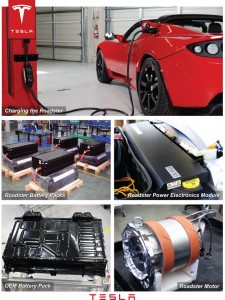 The following is an excerpt from the book Save Gas, Save the Planet. Copyright ©John Addison. All rights reserved.
The following is an excerpt from the book Save Gas, Save the Planet. Copyright ©John Addison. All rights reserved.
In 2007, hundreds of Silicon Valley’s brightest minds and most successful venture capitalists joined with many of California’s political leaders on a Friday night to celebrate California’s Cleantech Revolution and to raise money for the California League of Conservation Voters.
Many arrived in fuel-efficient hybrids. Martin Eberhard, then CEO and founder of Tesla Motors, arrived in a Tesla Roadster, a zero-emission vehicle that can accelerate from zero to 60 in 4 seconds. As I talked with him, it was easy to see why he was smiling.
When I rode in the Tesla, I held on as it accelerated, then held on to my wallet as I left this dream sports car. Hundreds had placed orders for Tesla Roadsters with 100 percent deposits of about $100,000 per auto. If you wanted this sports car, you needed to get in line behind Arnold Schwarzenegger, Google founders, and other luminaries who were eagerly awaiting their electric sports car.
With the average American household having two or more cars, the Tesla’s range is perfect for over 90 percent of Americans’ daily range. In less than 4 hours, typically while the vehicle is parked in the garage, the vehicle’s lithium-ion batteries can be recharged with a 220v outlet.
“Tesla intends to become a major car company with a full line of highly efficient – but also highly desirable – electric cars,” Eberhard said in 2007. “Our strategy is to enter at the high end of the market, where customers are prepared to pay a premium, and then move down-market as quickly as possible to higher production levels and lower prices with each successive model. This strategy also allows us to change radically the public perception of electric cars, opening the market for a full spectrum of electric car models.”
While major automakers are betting on new lithium battery chemistry in larger form factors, Tesla integrates 6,831 consumer-electronic-sized lithium batteries into an Energy Storage System, lowering the battery cost. Millions of these smaller batteries are made in high-volume, low-cost manufacturing. Amp hours keep increasing; prices keep falling.
Will advanced battery vehicle packs become affordable for most of us? The energy density of lithium-ion batteries has improved 500 percent in 15 years. With new energy storage chemistry, future electric vehicles could go much further at even lower cost. Japan’s METI has published a roadmap to reduce battery power cost 40 times by 2030, but a roadmap does not guarantee that this will happen. Experts debate whether battery costs can be significantly lowered.
Big-time success will not be easy for Tesla. Classic start-up problems delayed early deliveries of the Roadster by 18 months and pushed back plans for future five-seat sedans. Hundreds of pounds of weight needed to be added to the vehicle to meet established safety laws. Problems with a transmission supplier caused delays and ultimately resulted in software changes eliminating the need for a transmission. Tesla Motors is finding the field crowded with other automakers rolling out electric cars. Tesla is now financially strapped, going to Washington D.C. and asking for hundreds of millions in financial help. Tesla does deserve credit for generating renewed excitement for electric vehicles.
Tenacity paid-off. Tesla brought its exciting Roadster to market. The breakthrough 300-mile range Tesla Model-S Sedan is being ordered by the thousands. You can now drive the Roadster zero to 60 in 3.7 seconds.
Elon Musk’s Tesla Strategy for 2012
Get your discounted paperback or eBook copy of Save Gas, Save the Planet at Amazon. Gain a comprehensive understanding of electric cars, low-carbon fuels, and sustainable transportation.


“The breakthrough 300-mile range Tesla Model-S Sedan is being ordered by the thousands.”
Talk about being lazy with the facts…Only the most expensive version oof the Model S will have a 300-mile range and that’s according to Tesla and obviously has yet to bhe confirmed. The base version should have a 160 mile range, the intermediate version will cost another $10k and then another $10k for the 300 mile range version. So, with an estimated $57 base before delivery, meaning about $59k after, you’re now talking about an $80k car for that 300 mile range.
And all this assumes pricing won’t increase, as it did significantly with the Roadster and the recent Fisker Karma. I respect Tesla and obviously wish it well, but please don’t be so sloppy in your reporting. You make it seem like all versions of the Model S will have 300 miles of range and that’s far from the truth.